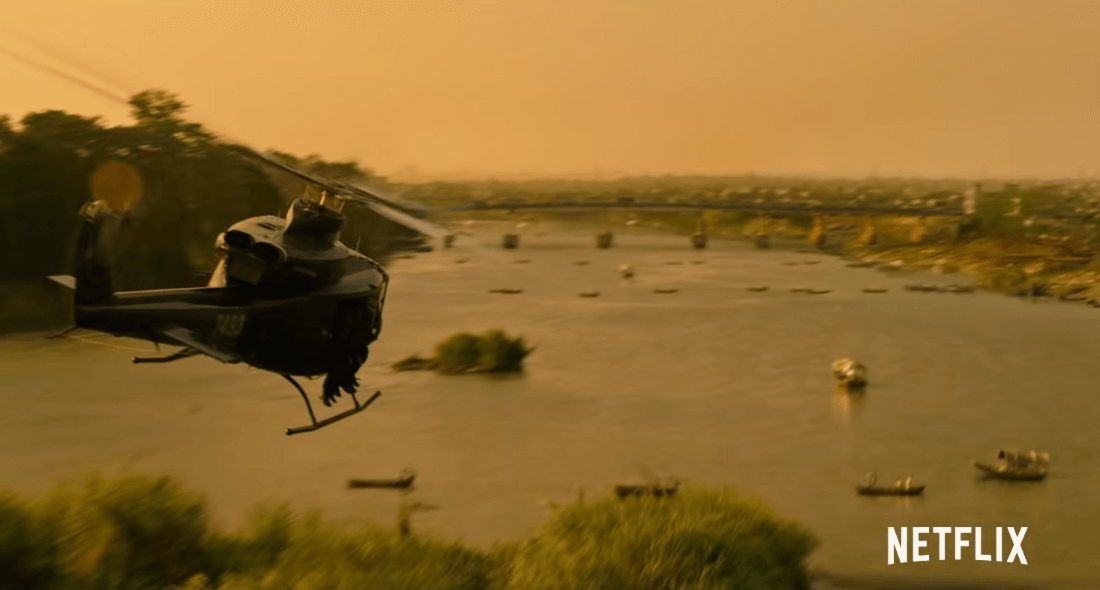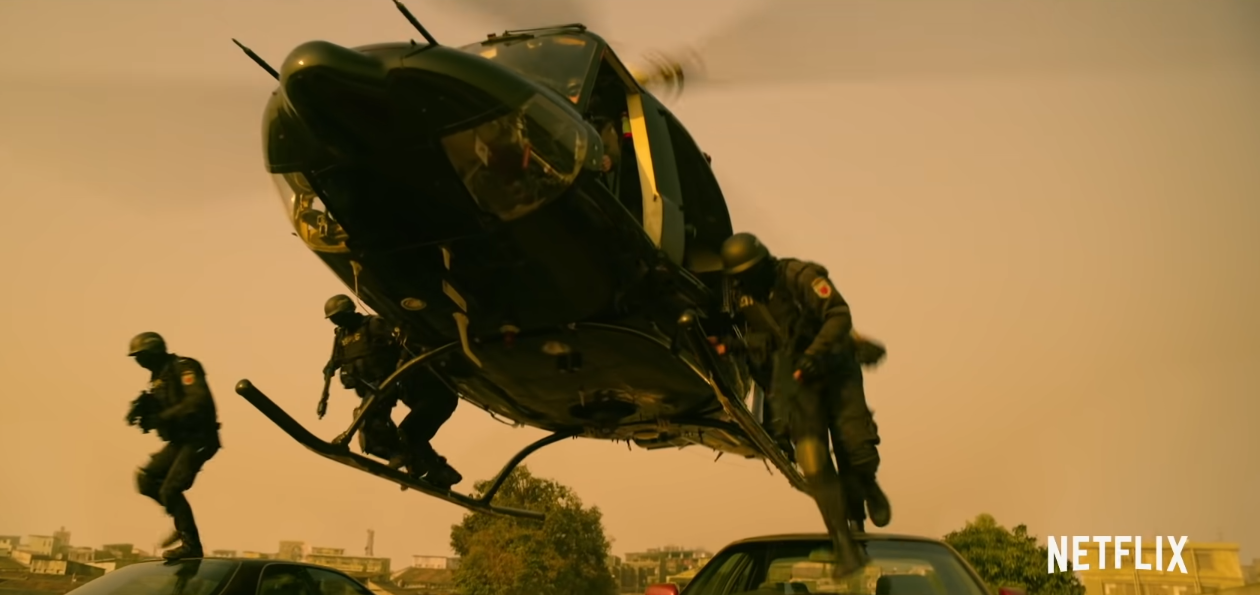The explosive, hero-versus-horde bridge battle at the climax of Netflix’s new action thriller Extraction involves two helicopters involved in on-screen action and one behind the camera capturing it all.

As Chris Hemsworth’s protagonist “Tyler” blasts his way through enemy troops across the span, he and an ally are set upon by a Bell 412 bristling with heavily armed special forces soldiers. Tyler’s own team prefers an Airbus EC120, which is supposed to provide the eponymous extraction to safety for Tyler and a boy he has pledged to protect from a Bangladeshi drug cartel.
Capturing it all from the cockpit of an Airbus AS350B3 AStar was pilot Aaron Fitzgerald, who spoke with Vertical on April 24 about filming scenes for the movie in Thailand, his career as a movie pilot and some of his other aerial exploits.
While the film takes place in Dhaka, Bangladesh, Fitzgerald and fellow film pilot Alex Anduze shot the aerial action in a town about 50 miles west of Bangkok, Thailand.
“We were there for a couple of weeks and did a whole bunch of complicated air-to-air scenes and air-to-ground and we worked together with the whole stunt team,” Fitzgerald said. “It was complicated and fun and exciting and everything all at once.”
The movie begins at the same bridge where the climactic shootout is staged and it was in and around that bridge that most of the aerial filming took place, Fitzgerald said.
“We had locked down a bridge over a river and we had all the stunt guys and a whole bunch of pyro[technics] all set up on this bridge, and the bulk of the action we were shooting had to do with a scene that was on that bridge and you’ll see that in the movie,” Ftizgerald said.
Fitzerald got the gig because another pilot and friend, Kevin LaRosa Jr., was busy flying for Top Gun: Maverick and was unable to take the Netflix job. Fitzgerald took LaRosa’s place on Extraction, though Kevin LaRosa Sr. did serve as the aviation ground coordinator on the film.
When Fitgerald arrived in Thailand, much of the planning for the aerial shots had been done and all the helicopters were in place, including the AStar camera ship that was flown in from Cambodia. The crew installed a Shotover K1 six-axis gyro-stabilized camera gimbal on that helicopter, which was used to film all the scenes with the blacked-out 412 that came from Indonesia.

Anduze, a former Sikorsky test pilot among other accomplishments in the U.S. Army and elsewhere, flew both the 412 and EC120.
“He was flying the 412 doing the on-camera stuff and I was chasing him around in the AStar doing the camera work,” Fitzgerald said. “We were doing some pretty tight coordination and it was a ton of fun.”
Thailand was fairly forgiving as a setting for helicopter flying, with a mean altitude of 1,000 feet above sea level. Working in the tropical heat was a nuisance, but Fitzgerald had an advantage in the camera ship.
“It was really hot,” he said. “The funny part of that is anyone who was with me would be laughing that I’m complaining about it, because my helicopter was the only one that had air conditioning. Everybody else was sweating, wilting, and I’m in the air conditioning trying to pretend like I was miserable, too. But I wasn’t.”
All the action begins on paper with cartoon-like storyboards drawn by the production team so the pilots can visualize what they need to capture. It’s up to the stunt pilots to figure out the best and safest way to capture that vision on film.
“We kind of have one foot in each discipline,” Fitzgerald said. “We’re aviators, but we’re also the creative guys, too. So, where those two worlds meet, that’s our little world where we live.”
“We take their creative direction and then apply what we know as far as how to operate helicopters in close proximity and how to fly formations safely, how to do countering passes and things like that.”

Each scene and the necessary flight plan is briefed to the entire stunt and film crew before any aircraft take flight. The pilots then begin rehearsing their flight paths before filming begins or any pyrotechnics are set off. Anduze and Fitzgerald conducted several rehearsal runs before each scene, tightening their patterns slightly after each sortie, until they were comfortable and satisfied they could catch the desired action.
“We know exactly what we’re going to do before we do it and then we try it first from a great distance apart,” he said. “We might be 300 feet apart and say ‘OK, that worked out, the timing was good, make some adjustments’ and then get closer and closer and closer. . . . What you see on camera is usually one of the last ones once we’ve worked our way into really close, tight formation or close passes . . . and then we time it with the pyro and what the camera needs. It all comes together like an orchestra.”
Fitzgerald has been flying “mostly full-time” for movies, sportscasting and television for about 20 years. “It’s how I make my living, but it’s not every day,” he said. He has been a camera pilot and aerial coordinator for some spectacularly complex live events, including the 2016 Heaven Sent project — in which his friend Luke Aikins skydived from 25,000 feet without a parachute, landing safely in a giant net — and Red Bull Stratos, which in 2012 saw Felix Baumgartner skydive out of a helium balloon high in the Earth’s stratosphere.
Fitzgerald said most of his time is spent planning, coordinating, filling out paperwork and preparing for flights instead of actually flying. When he isn’t flying for Hollywood, Fitzgerald is a helicopter aerobatic pilot for the Flying Bulls (and the only American on the Austria-based team).
“There’s a lot of emails, a lot of paperwork, a lot of drawing maps and working out storyboards and things like filling out insurance paperwork,” Fitzgerald said. “I always say it’s time for the fun part when I’m putting on my seat belt because all the paperwork is done and now we get to go fly.”
In an aviation industry increasingly crowded with larger, more capable unmanned aircraft that eliminate risk for human pilots, it is fair to ask whether stunt pilots have a future. While drones are often used in filmmaking and television, they have specific appropriate applications but will likely not supplant conventional helicopters, Fitzgerald said.

“When drones first came out in the form that they are today . . . there was a huge impact because it was a new toy and everybody wanted to use drones,” he said. “Everybody did and they did a good job because drones came a long way and the operators got really skilled. Then it kind of tapered off a little bit to where they are now, which is their natural niche.”
Many film and stunt pilots, LaRosa Jr. included, fly both helicopters and drones, Fitzgerald said. Both platforms continue to have a major role in filmmaking, but they overlap only slightly in their application, Fitzgerald said.
“They’ve found their sector of the market and we all work together really well,” he added. Drones “do the close-proximity, low-level . . . through doorways, stuff like that and then we do the traditional high-action, high-altitude stuff that you get better from conventional helicopters.”
Working for so long inside the helicopter carrying the camera, Fitzgerald has little desire to see more of his flying exploits on screen.
“If I had to choose one for life, I’d choose flying the camera,” he said. “The pilot flying lead is concentrating on where you’re going and concentrating on terrain avoidance and hitting the spots that we briefed, whereas the camera pilot gets to do all the creative work and make all the moves around the story ship.”
After two decades flying for films, Fitzgerald said the bridge scene in Extraction may be his favorite scene yet, though he had not watched the movie when he spoke to Vertical.
“I know that the action sequence we shot was super-cool, so I have a suspicion that’s going to be my favorite scene,” he said.









